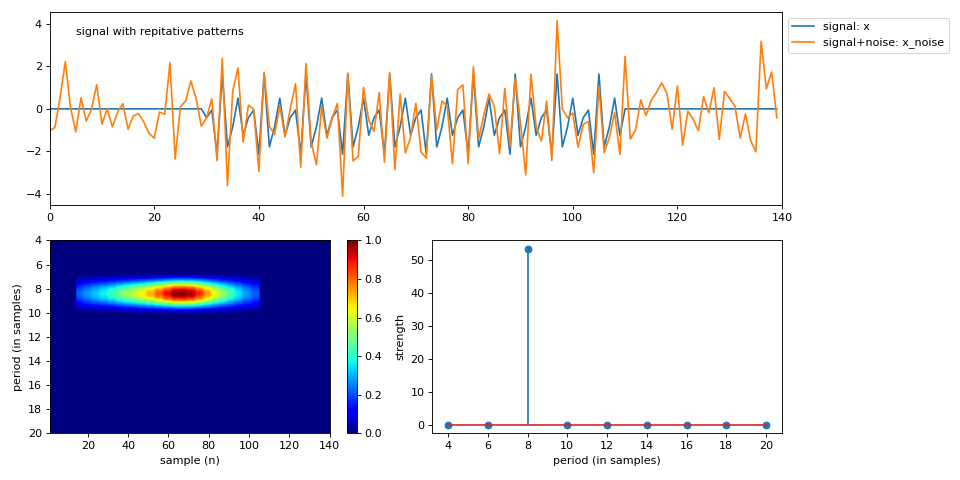spkit.RFB_prange¶
- spkit.RFB_prange(x, Pmin=1, Pmax=10, skip=1, Rcq=10, Rav=2, thr=0.2, Penalty=None, return_filters=False, apply_averaging=True)¶
Ramanujan Filter Banks for Estimation and Tracking of Periodicity with given range.
Ramanujan Filter Banks for Estimation and Tracking of Periodicity
Warning
NOTE: Use
ramanujan_filter_prangeinstead. That is most updated version.RFB_prangewill be removed in future release.for range of period given by Pmin and Pmax.
- Parameters:
- x = 1d array, sequence of signal
- Pmin = the smallest expected period. (default=1)
- Pmax = the largest expected period.
- skip = int >=1: if to skip period (default=1 –> no skipping) (>1 is not recomended)
- Rcq = Number of repeats in each Ramanujan filter
- Rav = Number of repeats in each averaging filter
- thr = Outputs of the RFB are thresholded to zero for all values less than Th*max(output)
- Penalty = penalty for each period shape=(len(Pmax)),
If None, then set to 1, means no penalty
- apply_averaging: bool, if False, no averaging is applied (deault=True)
- return_filters: bool, ifTrue, return FR - Ramanujan and FA - Averaging filters
- Returns:
- y = 2d array of shape = (len(x),Pmax), time vs period matrix, normalized
- if return_filters==True: also returns
- FR = list of Ramanujan Filters
- FA = list of Averaging Filters
See also
spkit# TODO
Notes
References
- [1] S.V. Tenneti and P. P. Vaidyanathan, “Ramanujan Filter Banks for Estimation
and Tracking of Periodicity”, Proc. IEEE Int. Conf. Acoust. Speech, and Signal Proc., Brisbane, April 2015.
- [2] P.P. Vaidyanathan and S.V. Tenneti, “Properties of Ramanujan Filter Banks”,
Proc. European Signal Processing Conference, France, August 2015.
Python impletation is done by using matlab code version from - http://systems.caltech.edu/dsp/students/srikanth/Ramanujan/
Examples
#sp.RFB_prange import numpy as np import matplotlib.pyplot as plt import spkit as sp np.random.seed(2) #period = 10 #SNR = 0 period = 8 x1 = np.zeros(30) x2 = np.random.randn(period) x2 = np.tile(x2,10) x3 = np.zeros(30) x = np.r_[x1,x2,x3] x_noise = sp.add_noise(x,snr_db=0) Pmin = 4 Pmax = 20 y,plist, FR, FA = sp.RFB_prange(x_noise,Pmin=Pmin, Pmax=Pmax, skip=2, Rcq=10, Rav=2, thr=0.2,return_filters=True) idx = np.argsort(np.sum(y,0))[::-1] print('top 10 periods: ',plist[idx[:10]]) plt.figure(figsize=(12,6)) plt.subplot(211) plt.plot(x,label='signal: x') plt.plot(x_noise, label='signal+noise: x_noise') plt.text(5,3.5,f'signal with repitative patterns') plt.xlim([0,len(x)]) #plt.xlabel('sample (n)') plt.legend(bbox_to_anchor=(1,1)) plt.subplot(223) im = plt.imshow(y.T,aspect='auto',cmap='jet',extent=[1,len(x_noise),Pmax,Pmin]) plt.yticks(plist) plt.colorbar(im) plt.xlabel('sample (n)') plt.ylabel('period (in samples)') plt.subplot(224) plt.stem(plist,np.sum(y,0)) plt.xlabel('period (in samples)') plt.ylabel('strength') plt.tight_layout() plt.show()






